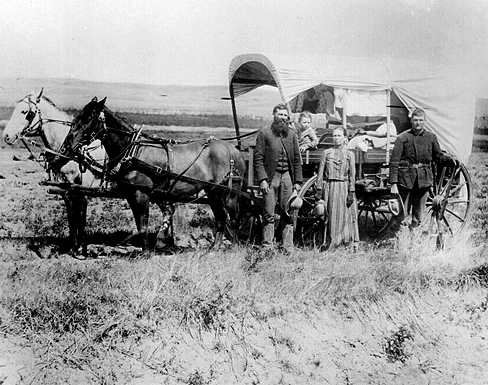
Homesteaders flooded onto the Great Plains to claim Indian lands unlawfully opened to settlement by the Dawes Act of 1887.
The Dawes
Act, or the General Allotment Act, took the name of its sponsor,
Senator Dawes of Massachusetts, and its passage was a watershed
moment in the evolution of federal Indian policy.
click here for more
With the
passage of Dawes, tribal land holdings were now up for grabs by
white settlers in the West. This was the official dissolution
of tribal landholdings and "the systematic destruction of tribal
leadership." Congress no longer bothered to rationalize its
side stepping of Indian separatism and independence, and it
effectively swept John Marshall's trust doctrine under the carpet
of history. Earlier policies inspired by Knox and Washington
- policies which embraced Indian self-government and sovereignty,
were now thoroughly discounted and legally diminished. The
early policies that sought to preserve traditional Indian cultures
and economies and to protect their land base and resources from
encroachment by non-Indian settlers had been dismantled or
discredited. Now, the Allotment Era programs codified that
which had been going on informally for years - the breaking-up of
Indian reservations into tiny 160 acre parcels.
Under the
Allotment plan, each Indian family and every individual tribal
member would receive a federal trust patent to a parcel of
land. All of the land remaining after tribal members received
their trust patent would be opened up to settlement. Surplus
lands were to be put up for sale to whites settlers or development
companies, and the proceeds would be held in trust by the
government for the benefit of the tribes (never happened).
Only one senator, Henry Teller, of Colorado, challenged allotment
as a thinly veiled land-grab and a wholesale abrogation of treaty
rights. He predicted that the Allotment Era would only
impoverish the Indian people even further.
The program ran
into difficulties thanks to a petard of the government's own
making. Treaties signed with tribes of the Great Plains often
required that future land cessions be approved by a majority of the
adult male members of the affected tribes. This hurdle became
a serious obstacle/challenge, particularly at a time when the U.S.
Army was engaged in an all out war with so many of the tribes that
Congress wanted to 'remove.' The Kiowas and Comanches
challenged the allotment program based on provisions of their 1867
treaty at Medicine Lodge Creek. The new Indian commissioner,
David Jerome, had the odious task of meeting with the tribes at
Fort Sill in 1892 and convincing them that they should give up all
of their surplus lands. Jerome made the pitch based on the
limited leverage at his disposal -- either give it up and receive
generous annuities from the Great White Fathers (a time-honored
ploy), or face starvation.
It is estimated
that Indians lost more than 86 million acres of their land base
during the Allotment Era - roughly 60% of their land - between 1887
and 1934, at which time the Roosevelt administration, calling
allotment a national disgrace, terminated the program.